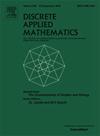晶格管中聚合物的缠结统计及四板解结
IF 1
3区 数学
Q3 MATHEMATICS, APPLIED
引用次数: 0
摘要
结熵猜想表明,n边晶格多边形的K型结数的指数增长率与未结多边形的指数增长率相同。此外,下一阶增长遵循n的幂律,其指数对k的结分解中的每一个素数结增加1。我们通过考虑管T *(一个简单立方格的∞×2×1子格)中的结和非分裂连接,提供了这一猜想的第一个证明。我们建立了T *中具有固定连杆型的n边多边形数目与n边解结数目渐近性的上界和下界。对于上界,我们证明了多边形可以通过编织插入来解结。对于下界,我们利用精确转移矩阵的信息证明了解结的模式定理。这一工作提供了关于四平面的新的结理论结果和关于点阵多边形的新的组合理论结果。连接到建模聚合物,如DNA在纳米通道突出。本文章由计算机程序翻译,如有差异,请以英文原文为准。
Entanglement statistics of polymers in a lattice tube and unknotting of 4-plats
The Knot Entropy Conjecture states that the exponential growth rate of the number of -edge lattice polygons with knot-type is the same as that for unknot polygons. Moreover, the next order growth follows a power law in with an exponent that increases by one for each prime knot in the knot decomposition of . We provide the first proof of this conjecture by considering knots and non-split links in tube , an sublattice of the simple cubic lattice. We establish upper and lower bounds relating the asymptotics of the number of -edge polygons with fixed link-type in to that of the number of -edge unknots. For the upper bound, we prove that polygons can be unknotted by braid insertions. For the lower bound, we prove a pattern theorem for unknots using information from exact transfer-matrices. This work provides new knot theory results for 4-plats and new combinatorics results for lattice polygons. Connections to modelling polymers such as DNA in nanochannels are highlighted.
求助全文
通过发布文献求助,成功后即可免费获取论文全文。
去求助
来源期刊

Discrete Applied Mathematics
数学-应用数学
CiteScore
2.30
自引率
9.10%
发文量
422
审稿时长
4.5 months
期刊介绍:
The aim of Discrete Applied Mathematics is to bring together research papers in different areas of algorithmic and applicable discrete mathematics as well as applications of combinatorial mathematics to informatics and various areas of science and technology. Contributions presented to the journal can be research papers, short notes, surveys, and possibly research problems. The "Communications" section will be devoted to the fastest possible publication of recent research results that are checked and recommended for publication by a member of the Editorial Board. The journal will also publish a limited number of book announcements as well as proceedings of conferences. These proceedings will be fully refereed and adhere to the normal standards of the journal.
Potential authors are advised to view the journal and the open calls-for-papers of special issues before submitting their manuscripts. Only high-quality, original work that is within the scope of the journal or the targeted special issue will be considered.
 求助内容:
求助内容: 应助结果提醒方式:
应助结果提醒方式:


